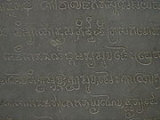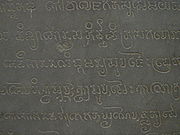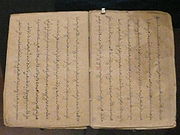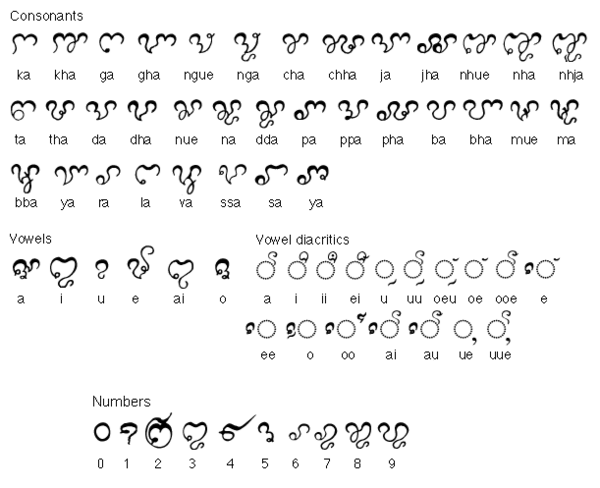
Cham alphabet
Encyclopedia


Abugida
An abugida , also called an alphasyllabary, is a segmental writing system in which consonant–vowel sequences are written as a unit: each unit is based on a consonant letter, and vowel notation is obligatory but secondary...
used to write Cham
Cham language
Cham is the language of the Cham people of Southeast Asia, and formerly the language of the kingdom of Champa in central Vietnam. A member of the Malayo-Polynesian branch of the Austronesian family, it is spoken by 100,000 people in Vietnam and up to 220,000 people in Cambodia . There are also...
, an Austronesian language spoken by some 230,000 Cham people in Vietnam
Vietnam
Vietnam – sometimes spelled Viet Nam , officially the Socialist Republic of Vietnam – is the easternmost country on the Indochina Peninsula in Southeast Asia. It is bordered by China to the north, Laos to the northwest, Cambodia to the southwest, and the South China Sea –...
and Cambodia
Cambodia
Cambodia , officially known as the Kingdom of Cambodia, is a country located in the southern portion of the Indochina Peninsula in Southeast Asia...
. It is written horizontally left to right, as is English.
History
The Cham script is a descendant of the Brahmi scriptBrāhmī script
Brāhmī is the modern name given to the oldest members of the Brahmic family of scripts. The best-known Brāhmī inscriptions are the rock-cut edicts of Ashoka in north-central India, dated to the 3rd century BCE. These are traditionally considered to be early known examples of Brāhmī writing...
of India, itself a descendant of the Aramaic script. Cham was one of the first scripts to develop from a South India
South India
South India is the area encompassing India's states of Andhra Pradesh, Karnataka, Kerala and Tamil Nadu as well as the union territories of Lakshadweep and Pondicherry, occupying 19.31% of India's area...
n Brahmi script called grantha
Grantha
Grantha script is an ancient script that was widely used between the 6th century and the 19th century CE to write classical Sanskrit and Manipravalam by Tamil speakers in Southern India, particularly in Tamil Nadu and Kerala, and is still in restricted use in traditional vedic schools...
, some time around 200 AD. It came to Southeast Asia as part of the expansion of Hinduism
Hinduism
Hinduism is the predominant and indigenous religious tradition of the Indian Subcontinent. Hinduism is known to its followers as , amongst many other expressions...
and Buddhism
Buddhism
Buddhism is a religion and philosophy encompassing a variety of traditions, beliefs and practices, largely based on teachings attributed to Siddhartha Gautama, commonly known as the Buddha . The Buddha lived and taught in the northeastern Indian subcontinent some time between the 6th and 4th...
. Hindu stone temples of the Champa
Champa
The kingdom of Champa was an Indianized kingdom that controlled what is now southern and central Vietnam from approximately the 7th century through to 1832.The Cham people are remnants...
civilization contain both Sanskrit
Sanskrit
Sanskrit , is a historical Indo-Aryan language and the primary liturgical language of Hinduism, Jainism and Buddhism.Buddhism: besides Pali, see Buddhist Hybrid Sanskrit Today, it is listed as one of the 22 scheduled languages of India and is an official language of the state of Uttarakhand...
and Chamic stone inscriptions. The earliest inscriptions in Vietnam are found in the Mỹ Sơn temple complex. Dated to around 400 CE
Common Era
Common Era ,abbreviated as CE, is an alternative designation for the calendar era originally introduced by Dionysius Exiguus in the 6th century, traditionally identified with Anno Domini .Dates before the year 1 CE are indicated by the usage of BCE, short for Before the Common Era Common Era...
, the oldest is written in faulty Sanskrit. After this, inscriptions alternate between Sanskrit and the Cham language of the times.
Cham kings studied classical Indian texts such as the Dharmaśāstra
Dharmasastra
Dharmaśāstra is a genre of Sanskrit texts and refers to the śāstra, or Indic branch of learning, pertaining to Hindu dharma, religious and legal duty. The voluminous textual corpus of Dharmaśāstra is primarily a product of the Brahmanical tradition in India and represents the elaborate scholastic...
, and inscriptions make reference to Sanskrit literature
Sanskrit literature
Literature in Sanskrit begins with the Vedas, and continues with the Sanskrit Epics of Iron Age India; the golden age of Classical Sanskrit literature dates to late Antiquity . Literary production saw a late bloom in the 11th century before declining after 1100 AD...
. Eventually, while the Cham and Sanskrit languages influenced one another, Cham culture assimilated Hinduism, and Chams were eventually able adequately express the Hindu religion in their own language. By the 8th century, the Cham script had outgrown Sanskrit and the Cham language was in full use. Most preserved manuscripts focus on religious rituals, epic battles and poems, and myths.
Modern Chamic languages have the Southeast Asian areal features of monosyllabicity, tonality
Tone (linguistics)
Tone is the use of pitch in language to distinguish lexical or grammatical meaning—that is, to distinguish or inflect words. All verbal languages use pitch to express emotional and other paralinguistic information, and to convey emphasis, contrast, and other such features in what is called...
, and glottalized consonants
Glottalization
Glottalization is the complete or partial closure of the glottis during the articulation of another sound. Glottalization of vowels and other sonorants is most often realized as creaky voice...
. However, they had reached the Southeast Asia mainland disyllabic and nontonal. The script needed to be altered to meet these changes.
The Cham now live in two groups: The Western Cham of Cambodia and the Eastern Cham (Phan Rang Cham) of Vietnam. For the first millennium AD, the Chamic languages
Chamic languages
The Chamic languages, also known as Aceh–Chamic and Achinese–Chamic, are a group of ten languages spoken in parts of Cambodia, Vietnam, and Hainan, classified as Malayic languages in the Austronesian language family....
were a dialect chain along the Vietnam coast. The breakup of this chain into distinct languages occurred once the Vietnamese pushed south, causing most Cham to move back into the highlands while some like Phan Rang Cham became a part of the lowland society ruled by the Vietnamese. The division of Cham into Western and Phan Rang Cham immediately followed the Vietnamese overthrow of the capital. Each uses a distinct variety of the script, although the former are mostly Muslim
Muslim
A Muslim, also spelled Moslem, is an adherent of Islam, a monotheistic, Abrahamic religion based on the Quran, which Muslims consider the verbatim word of God as revealed to prophet Muhammad. "Muslim" is the Arabic term for "submitter" .Muslims believe that God is one and incomparable...
and now prefer to use the Arabic alphabet
Arabic alphabet
The Arabic alphabet or Arabic abjad is the Arabic script as it is codified for writing the Arabic language. It is written from right to left, in a cursive style, and includes 28 letters. Because letters usually stand for consonants, it is classified as an abjad.-Consonants:The Arabic alphabet has...
. The latter are mostly Hindu
Hindu
Hindu refers to an identity associated with the philosophical, religious and cultural systems that are indigenous to the Indian subcontinent. As used in the Constitution of India, the word "Hindu" is also attributed to all persons professing any Indian religion...
and still use the Cham script. During French colonial times, both groups had to use the Latin alphabet
Latin alphabet
The Latin alphabet, also called the Roman alphabet, is the most recognized alphabet used in the world today. It evolved from a western variety of the Greek alphabet called the Cumaean alphabet, which was adopted and modified by the Etruscans who ruled early Rome...
.
Usage
The script is highly valued in Cham culture, but this does not mean that many people are learning it. There have been efforts to simplify the spelling and to promote learning the script, but these have met with limited success. Traditionally, boys learned the script around the age of twelve when they were old and strong enough to tend to the water buffalo. However, women and girls did not typically learn to read.Structure
As an abugidaAbugida
An abugida , also called an alphasyllabary, is a segmental writing system in which consonant–vowel sequences are written as a unit: each unit is based on a consonant letter, and vowel notation is obligatory but secondary...
, Cham writes individual consonants supplemented by obligatory vowel diacritic
Diacritic
A diacritic is a glyph added to a letter, or basic glyph. The term derives from the Greek διακριτικός . Diacritic is both an adjective and a noun, whereas diacritical is only an adjective. Some diacritical marks, such as the acute and grave are often called accents...
s tacked onto the consonant.

Inherent vowel
An inherent vowel is part of an abugida script. It is the vowel sound which is used with each unmarked or basic consonant symbol....
[a] which does not need to be written. The nasal consonants, [m], [n], [ɲ], and [ŋ] (the latter two transliterated nh and ng in the Latin alphabet) are exceptions, and have an inherent vowel [ɨ] (transliterated eu). A diacritic called kai, which does not occur with the other consonants, is added below a nasal consonant to write the [a] vowel.
Cham words contain vowel and consonant-vowel (V and CV) syllables, apart from the last, which may also be CVC. There are a few characters for final consonants in the Cham script; other consonants merely extend a longer tail on the right side to indicate the absence of a final vowel.
Unicode
Cham script was added to the UnicodeUnicode
Unicode is a computing industry standard for the consistent encoding, representation and handling of text expressed in most of the world's writing systems...
Standard in April, 2008 with the release of version 5.1.
The Unicode block for Cham is U+AA00 ... U+AA5F. Grey areas indicate non-assigned code points:
Literature
- Blood, Doris (1980a). Cham literacy: the struggle between old and new (a case study). Notes on Literacy 12, 6-9.
- Blood, Doris (1980b). The script as a cohesive factor in Cham society. In Notes from Indochina, Marilyn Gregersen and Dorothy Thomas (eds.), 35-44. Dallas: International Museum of Cultures.
- Blood, Doris E. 2008. The ascendancy of the Cham script: how a literacy workshop became the catalyst. International Journal of the Sociology of Language 192:45-56.
- Brunell, Marc. 2008. Diglossia, Bilingualism, and the Revitalization of Written Eastern Cham. Language Documentation and Conservation 2.1: 28-46. (Web based journal)
- Moussay, Gerard (1971). Dictionnaire Cam-Vietnamien-Français. Phan Rang: Centre Culturel Cam.
- Trankell, Ing-Britt and Jan Ovesen (2004). Muslim minorities in Cambodia. NIASnytt 4, 22-24. (Also on Web)

